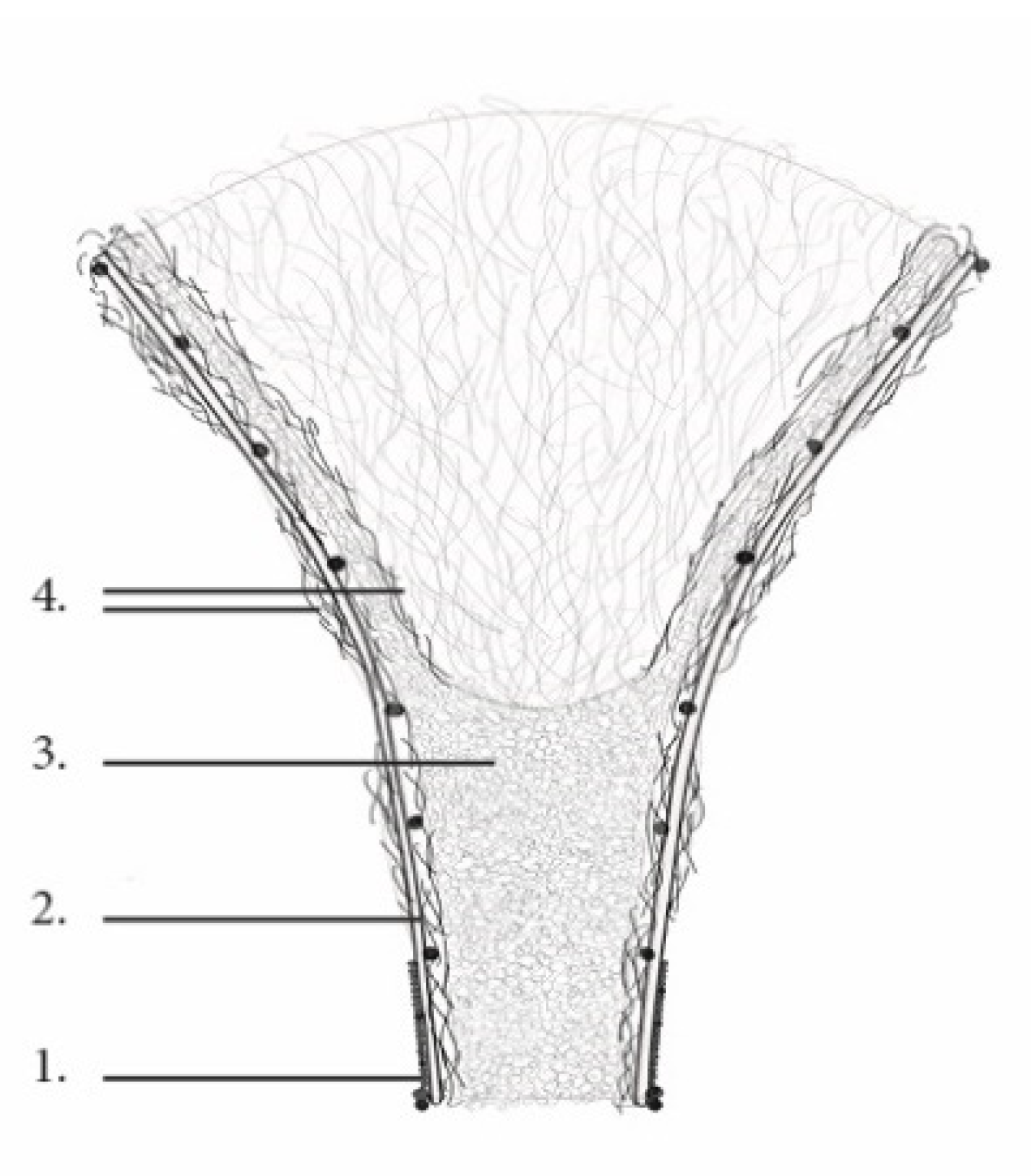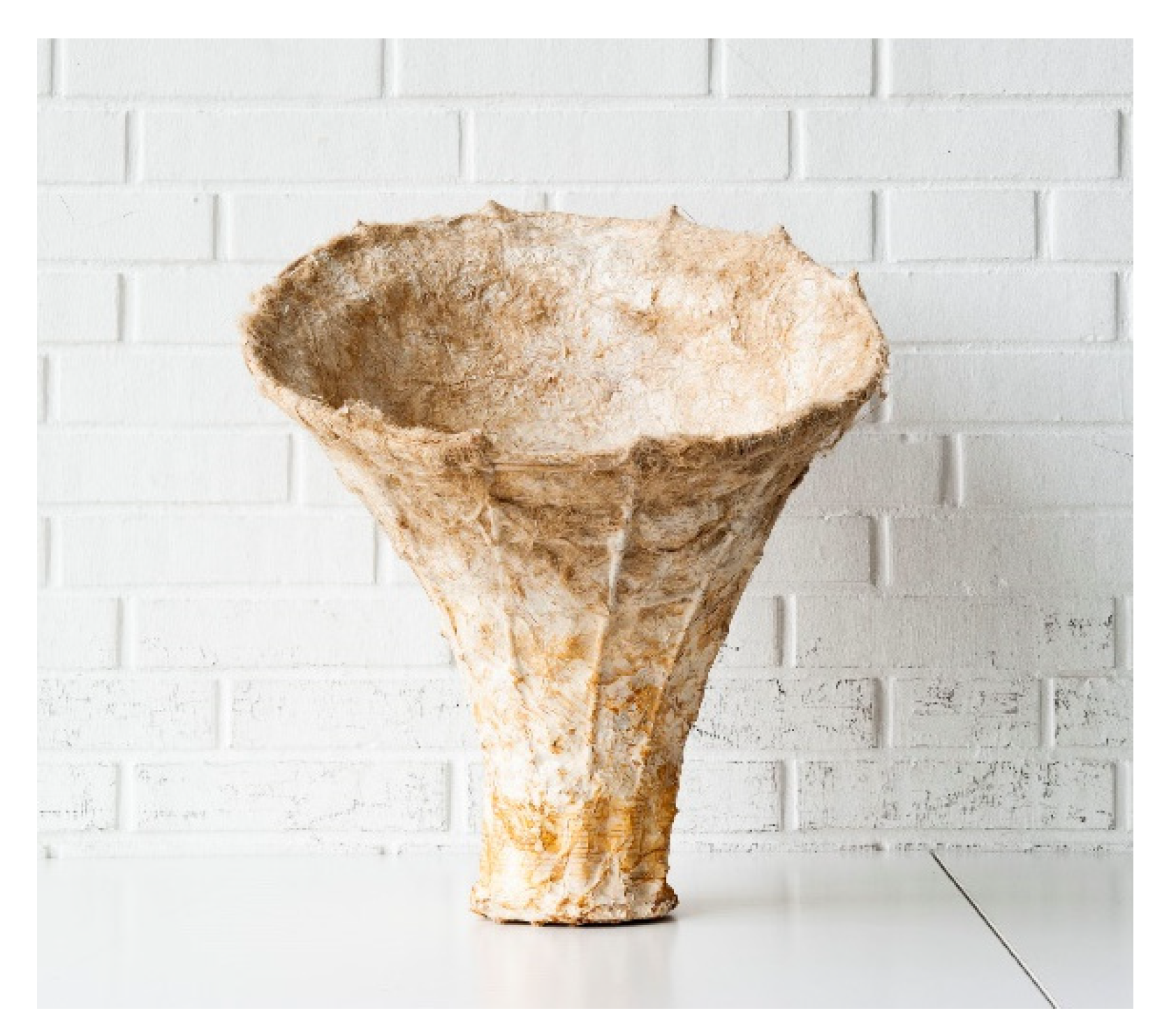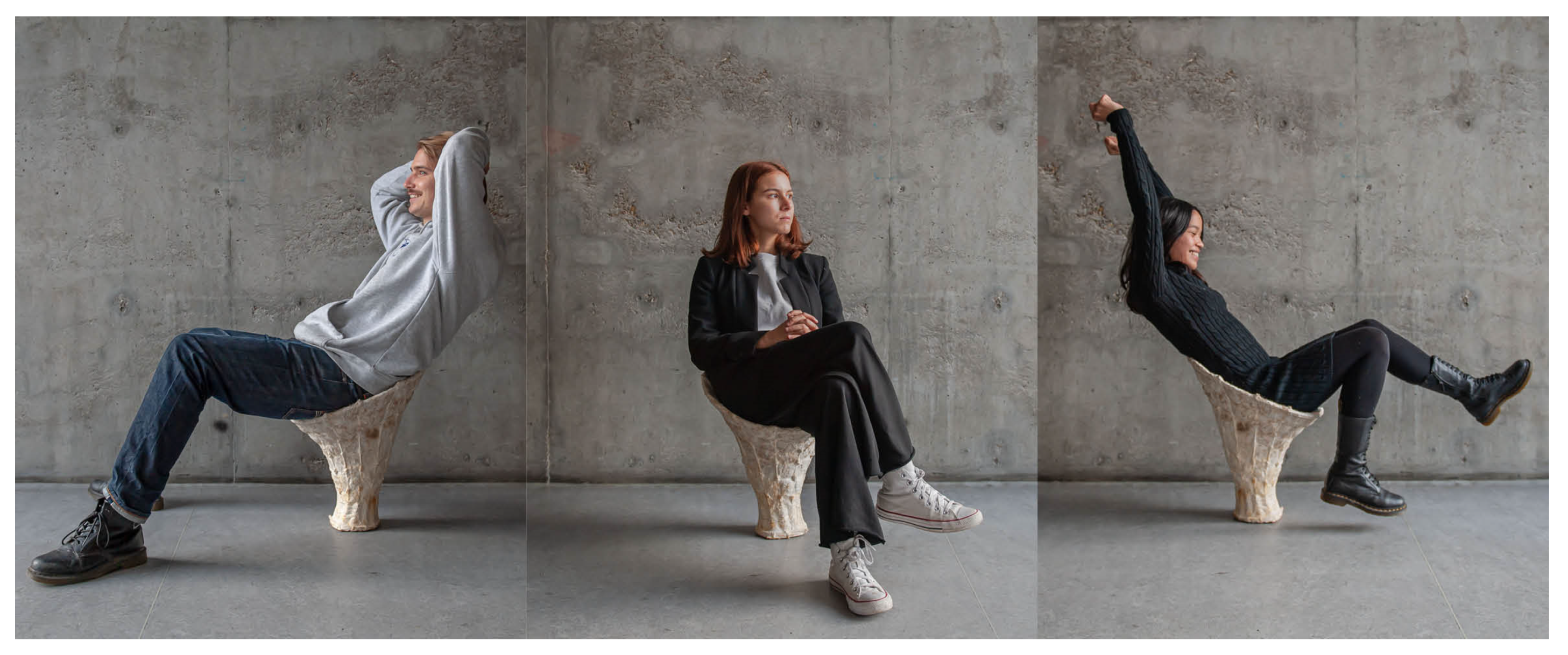Counteracting the usual fabrication techniques, the proposed design method aims to guide mycelium’s growth on a natural rattan framework that serves as a supportive structure for the mycelium substrate and its fiber reinforcement. The rattan skeleton is integrated into the finished composite product, forming a fully biodegradable unit, which can support a load beyond 20 times its own weight.
1. Introduction
Since the linkage between human consumption behavior and the rapidly increasing global warming becomes evident, life in the 21st century faces an ongoing environmental crisis. The use of conventional building materials in the global industry impacts largely on climate change by destructing more than 45 percent of global resources and emitting up to 40 percent of the energy-related carbon dioxide into the atmosphere [1][2]. Within an ever-growing society, there is and will be a constant need for materials, and consumption prevention is not the optimal choice. Awareness of already existing alternative systems is crucial for achieving sustainability. Waste can only be repurposed as a new resource if the majority of building components can be disassembled and returned to their original material cycles separately [3][4] Fungal substrates are considered waste products and thus, can be used as compost and in a range of other applications [5]. By decreasing the cradle-to-gate manufacturing in the building sector, construction processes could be optimized to meet the social, ecologic, and economic values of the future generation. While the composting process was absent during the non-regenerative production line of the 18th and 19th centuries, at the present time, reorientation processes take place towards the cultivation of natural resources by breeding, raising, or growing materials. With sufficient improvement of the current fabrication methods, which are biologically driven and technologically supported, designing and manufacturing sustainable objects are goals within reach [3][6][7].
With an increasing demand for lightweight and durable building materials, fiber-reinforced polymer composites are considered a reliable alternative to conventional building materials such as concrete and steel. Determined by their components and fabrication methods, the structural and functional performance of fiber-reinforced polymers (FRC) can be adjusted to match the preferred application. Natural fiber-reinforced polymer (NFRP) composites consist of a high-strength reinforcement and a high-ductility matrix. Cellulosic fibers are highly sustainable and commonly used as reinforcement in composites. They are commonly agricultural residues; hence they enhance the ecological role of renewable resources, can be found in nature, are non-toxic, renewable, cost-effective, and allow bonding with different matrices. Bio-based composites with mineral and petrochemical matrices are widely used. However, their full biodegradability is costly to achieve due to the complex separation of the composites into their initial components, causing limited end-of-life options. Recyclability of composites with bio-based matrices is also limited, as degradation can only take place in specific industrial composting conditions
[4][6][8]. Alternatively, mycelium-based matrices are organic matter and fully biodegradable, fulfilling the requirements of the circular material life cycle
[8][9]. Since the main constituents of mycelium composites are fibrous substrates, lignocellulosic agricultural or forestry by-products and wastes such as straw and hemp, or porous substrate, e.g., sawdust, the costs of mycelium composites are low and enable waste upcycling
[10][11]. The results of the first methods for the disintegration of mycelium-based composites (Ganoderma resinaceum and hemp fibers) in soil have strengthened their biodegradability, with a maximum weight loss of 43% after 16 weeks
[12].
2. Mycelium-Based Composites
Mycelium-based biocomposites are perceived as a sustainable and competitively performing material alternative in several application fields, including thermal and acoustic insulation, or as a replacement to standard expanded polystyrene packaging
[10]. Because of mycelium’s high compressive mechanical properties, previously it has been focused on compression-only structural applications. Further applications of mycelium in design and construction have also been a topic of further
[13].
By Jiang (2017)
[14] examines the performance of mycelium-bound sandwich composites by measuring the flexural stiffness of the composites’ core and skin layers. During this experiment, a discontinuous composite core is placed in between two skin layers of continuous and randomly oriented cellulosic fibers. Interfacial bonding between the core composite and the outer binding layers was possible because of mycelium’s ability to grow through the fiber matrix and effectively bind with the fibers. The compressive properties of the composite are mainly dependent on the core stiffness and can be improved through highly cellulosic skin materials
[10].
3. Fiber Reinforcement and Rattan Framework samples
3.1. Skin Materials
Growth on different skin materials is tested:
3.1.1 Hemp Sheets
The first sample contains mycelium substrate, compressed into a soft mold of randomly oriented hemp fibers (Figure 1a). Due to the high density of the hemp sheets, water absorption levels are high and ensure constant moisture levels throughout the growth process. Because of that, the mycelium grew beyond the geometrical restrictions of the soft mold and along the outer edges of the hemp sheets. The high growth density prevents separation during the shrinking process and results in the stiffest sample and most successful binding outcome. The concept of a “soft mold” suggests the use of a natural frame that is integrated during the fabrication process and stays embedded in the end-product. The outcome of this initial test was successful, resulting in new ideas for alternate molding methods.
Figure 1. Results of grown on different skin materials: (a) hemp sheets, (b) jute sheets, (c) knitted hemp rope.
3.1.2. Jute Sheets
In the second experiment, pre-woven bidirectional jute sheets are used as a skin alternative (Figure 1b). The low thickness and density of the fibers do not contribute to containing sufficient moisture levels, which results in the sample drying before enough growth is achieved. Consequently, uneven shrinkage and separation between substrate and skin layer occurred.
3.1.3. Knitted Hemp Rope
Throughout the third experiment, knitted hemp rope is used as an alternate outer skin (Figure 1c). While compressing the mycelium substrate into the mold, the too loosely knitted skin resulted in a deformed overall shape. Similar moisture deficiency as in the previous observation occurs. The sample’s final state is less rigid and hardly successful, due to the uneven distribution of the substrate.
3.2 Multi-Layer Samples
Two further experiments with hemp were carried out:
3.2.1. Hemp Sheet Sandwich
As an alternative to filling up a voluminous mold, in this experiment, the mycelium substrate is pressed between two hemp mat layers to form a thin and rigid sandwich element. As in the above-described example, the density of the hemp fibers ensures a constantly moist growth environment. No separation between substrate and hemp sheets is visible. This sandwich results in the stiffest sample (Figure 2b).
Figure 2. (a) Results of multilayer composite, (b) hemp mat sandwich.
3.2.2. Multilayer Composite: Rattan, Loose Hemp Fibers, Mycelium Substrate with Chopped Hemp Fibers
In the final material test, loose hemp fibers act as a substitute for the mechanically compressed hemp sheets, and rattan reinforcement is introduced in between the mycelium substrate. Due to the greater airflow between the randomly oriented loose hemp fibers, there is proportionally more space for the mycelium to spread, still resulting in a stiff sample but also exhibiting higher elasticity. Rattan acts as an integral structural reinforcement, as it successfully merges with the mycelium. This compatibility leads to a significant increase in the overall stiffness (Figure 2a).
4. Application / Physical prototypes
Rattan serves as the framework in this fabrication approach since it is incorporated with the structural system and, as with all other components, is fully compostable. The number of reinforcement rods in the computed design is doubled to ensure the proper positioning of the hemp fiber and mycelium composite layers.
The rattan is the outer supporting skeleton; loose hemp fibers are flexible sub-layers for the mycelium to grow through and bind with the skeleton. Mycelium pre-grown substrate forms the core, which is subsequently covered with loose hemp fibers (Figure 3). All materials must be sterilized before the assembly process begins. After cooling down to room temperature, flour must be added to the wet hemp fibers. The rattan should be still wet so that one can bend the rods into their initial shape. The connection of vertical and horizontal members is secured with sterilized jute rope using traditional square knot techniques. When the skeleton is assembled, the fibers can be placed on top so that no gaps emerge during the substrate placement. This layer is approximately 1 cm thick. The pre-grown substrate is then mixed with psyllium husk until reaching a clay-like texture. Afterwards, the mixture is evenly distributed on top of the wet hemp fibers with a thickness of 3 cm. An additional centimeter of wet hemp fibers follows. The multi-layer composite is then wrapped in perforated plastic foil to sustain moisture but also provide air circulation. To ensure constant moisture and nutritional levels, occasional spraying with a water-flour solution takes place. The assembled piece needs to be kept in a sterile environment for a minimum of 5 days while sufficient growth density can be reached. Baking of the prototype at 80 degrees is then necessary to improve its compressive strength and to stop the growth process until the sample does not lose any further weight. While baking, a color change from white to a darker beige or brown is expected due to the hemp fibers.

Figure 3. Layers: 1. Rattan ⌀ 2 mm, 2. Rattan ⌀ 5 mm, 3. Mycelium substrate, 4. Hemp fibers.
4.1. Comparison
Three scenarios are explored in order to determine the importance of including a rattan framework in the specified system:
4.2. Composite without Rattan Reinforcement (Assumption)
Since a full prototype without a rattan skeleton was not created during this, this scenario is an assumption. Although the soft mold samples indicate excellent merging capabilities with the mycelium-based core, the whole composite might not withstand the applied forces without the core breaking or splitting. A framework to fix the soft fabric to fill in the substrate, or an external mold, would be required to construct a composite without a rattan skeleton. During the growing and drying phases, the composite might deform unevenly due to the randomly oriented fibers.
4.3. Composite with Rattan Reinforcement
The tensile capabilities of the mycelium-based rattan-reinforced composite have improved due to higher water content within the rods and wet hemp fibers, while the whole composite performs best under compression. Rattan’s load-bearing capacity is advantageous not only when merging with mycelium but also during the growing and drying phase to minimize uneven shrinking. The bottom support’s finely woven rattan maintains the core in place and prevents breakage.
4.4. Rattan without Mycelium Matrix
Since rattan rods perform best under bending, this research demonstrated that rattan might be used as reinforcing rods in a mycelium composite. In the first attempt, the behavior of the rattan framework was tested through a seating test before placing fibers and substrate, which resulted in severe, irreversible deformation of the framework.
4.5. Physical Prototypes
In the first attempt, with an insufficient amount of 3 L of the substrate, the stool is able to hold the needed load but is still relatively unstable. The shell thickness varies from 0.5 cm to 1.5 cm. To improve its structural performance, the bottom radius is upscaled by 3 cm, which also prevents the stool from slipping. Additionally, in the second attempt, the amount of mycelium substrate is doubled, and 2.3 times more fibers are used. Psyllium husk is added to the substrate for improved material distribution, giving it a clay-like texture. In both attempts, mycelium binds effectively with all the elements. Significant growth has been observed in the vertical rattan members, particularly through the capillaries of the rattan. This is caused by the capillary effect, transporting the water, nutrients, and mycelium throughout the whole length. Due to increasing water content within the rods and wet hemp fibers, the tensile properties of the mycelium-based rattan-reinforced composite have improved, whereas the whole composite performs best under compression. In addition to rattan’s load-bearing capabilities when merging with mycelium, it is also beneficial in preventing uneven shrinking throughout the growing and drying process. This project presents a successful binding capacity of the substrate with the skin materials, leaving no evidence of separation. The densely woven rattan at the bottom support keeps the substrate in place and prevents breakage. The final prototype (Figure 4) weighs 3.7 kg and can support more than 20 times its own weight, demonstrating high structural capabilities (Figure 5).

Figure 4. Physical prototype, main dimensions: height 45cm, upper radius: 22, bottom radius: 7
Although the developed physical prototype has proven mycelium’s load-bearing and binding capacities, there is still a lot of space for further research on the structural capabilities of mycelium-based composites in large-scale applications. Possible interior applications of the developed system can be in partition walls or sound insulation panels. The necessity for interruption of the growth process presents limitations in the manufacturing on an architectural scale, due to the need for an industrial oven with a restricted size. That obstacle can be overcome through segmentation of the structural object into separate pre-grown and assembled on-site modules. For interior applications, Mycomerge presents a successful concept of material efficiency and load-bearing capacity of mycelium-based structures. Water content and moisture during growth are critical for the successful bonding of the rattan rods; otherwise, the mycelium will not grow onto the rattan’s surface. As an outcome, the tensile characteristics of the rattan rods and the mycelium composite will degrade, resulting in possible separation. Rattan is utilized as an exterior skeleton; however, given the common reinforcement methods, such as steel rebar in concrete, more testing of layering, rattan binding, and reinforcement capabilities are required. In comparison with other fabrication techniques, working with rattan as a structural and form-giving framework eliminates the necessity of an external mold. Forming double-curved geometries can also be achieved.
The materials used in this prototype are only agricultural waste products, which can be sourced regionally. Because all the components can be grown, this approach has no limitations in terms of resources. Mycomerge is fully biodegradable and hence promotes an eco-friendly alternative to the commonly used conventional materials, aiming toward sustainability in the building industry.
Figure 5. Seating tests up to 90 kilos.










